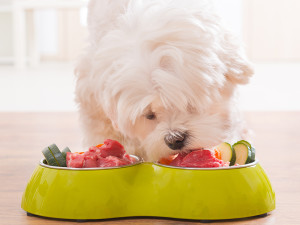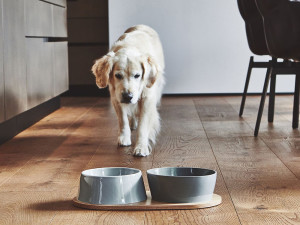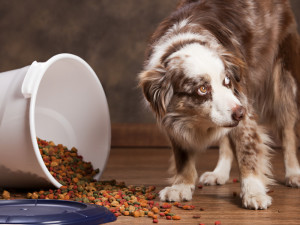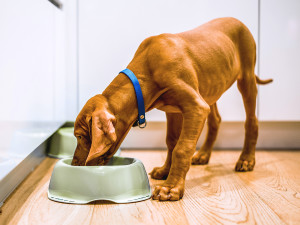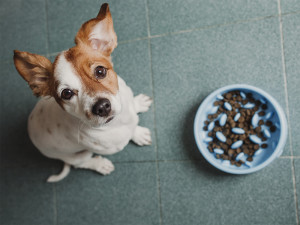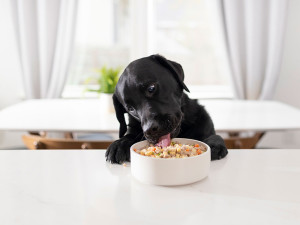You’re Probably Not Washing Your Dog’s Bowl Enough
And according to a new study, it’s putting their health at risk.
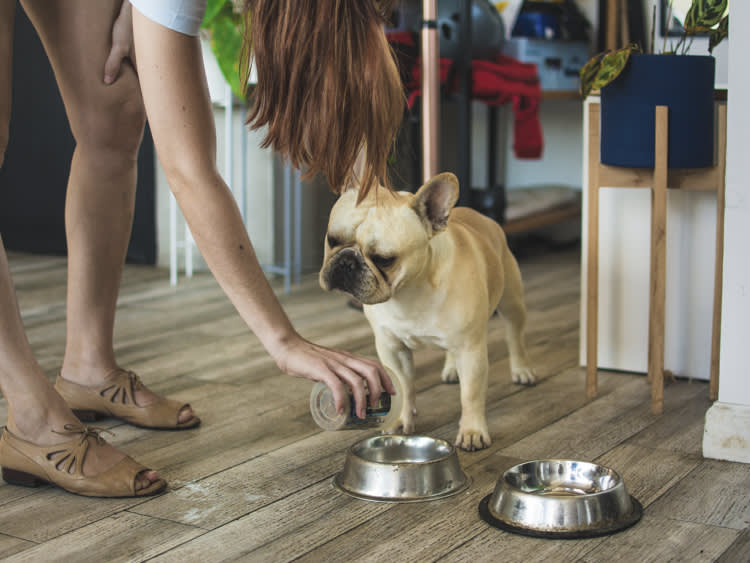
Share Article
You wouldn’t dish up your dinner on a dirty plate but you’re probably pouring your dog’s kibble into a bacteria-laden bowl.
“Previous studies have found medically important and potentially pathogenic bacteria…that bacteria can be shared or spread around the house,” explains Dr. Emily Luisana, a veterinary nutritionist and author of a new study on pet parents’ food handling and hygiene practices. “The bacteria that’s harbored in our pets’ bowls may not stay there.”
Despite the potential health risks to pets and their guardians, Dr. Luisana’s researchopens in new tab showed that 22 percent of pet parents washed their dog’s food and water bowls once a week while 18 percent washed them less than once every three months (or not at all).
The study also showed that less than 25 percent of dog parents washed the scoops used to dish out the food or washed their hands before and after feeding their dogs, which also increases the odds of spreading bacteria like MRSA, salmonella, and E. coli — and less than five percent of participants admitted to not knowing there were federal guidelinesopens in new tab that include recommendations for washing pet bowls.

Dr. Luisana found that washing your dog’s bowl after every meal — yes, every meal — is an important practice when it comes to protecting your pet from exposure to potentially harmful bacteria.
As part of the study, 417 dog parents were divided into three groups: Group A followed the Food and Drug Administration guidelines for pet food handling and dish hygiene; Group B followed FDA guidelines for pet and human food handling and dish hygiene; and Group C continued their regular feeding and food handling practices.
Based on food dish swabs, there were significant decreases in bacteria in the pet food bowls in groups A and B compared to group C. “As washing the bowls demonstrated a significant reduction in bacteria, we can safely assume that infrequent washing was a contributor to bacterial growth,” she says. The results held true whether dog parents fed wet or dry food or used bowls made of plastic, stainless steel, or other materials but Dr. Luisana admits that a larger sample size could change those findings.
Integrative veterinarian Dr. Karen Becker, believes that pet parents who feed kibble may have a false sense of security about the cleanliness of their dog bowls. In an articleopens in new tab posted on Mercola’s Healthy Pets website, Dr. Becker said, “Those pet parents may not realize that while dry food doesn’t leave the same obvious mess behind as canned and raw or fresh food, it’s just as likely, and even more likely in some cases, to be contaminated with salmonella, E. coli, or other types of bacteria. So, while the bowl may look clean after your pet eats his dry food, to safeguard the health of human family members, it’s just as important to wash kibble bowls, as it is to wash bowls used for moist diets.”
To further reduce exposure to toxins, Dr. Becker suggests using food safe 18-gauge stainless steel, porcelain, or glass food and water bowls. Plastic, she explains, can degrade over time. Separate researchopens in new tab found that salmonella, E. coli and other harmful bacteria that could make pets and people sick, was more common in ceramic and plastic pet food and water dishes than those made from stainless steel.
Whether you feed your dog kibble or canned food or serve their dinner in stainless steel or plastic bowls, Dr. Luisana suggests following the FDA guidelines for the safe handling of pet food which include:
Washing your hands before and after handling pet food and treats.
Washing pet food bowls and scoops with soap and hot water after each use.
Using a scoop or spoon, not the bowl, to dish up pet food.
Storing pet food in its original bag.
“The FDA recommendations, at first glance, can seem like a time-intensive to-do list…the key to following the FDA's recommendations is just like any good habit, set yourself up for success and make it part of your routine,” Dr. Luisana says. “Keeping dog dishes clean…can help reduce risk [and] small changes like having multiple pet bowls can make a big difference in our ability to stick with it in the long term.”
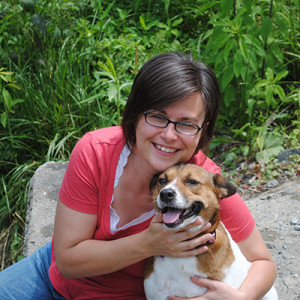
Jodi Helmer
Jodi Helmer is a North Carolina-based freelance writer who shares her home with an embarrassing number of rescue dogs and relies on four feral cats to patrol the barn. When she isn’t refilling food and water dishes, Jodi writes about animals for Scientific American, Sierra, WebMD, AKC Family Dog, Living the Country Life, and Out Here.
Related articles
![Dog standing next to dog food spilling out of a container]()
10 Dog Food Containers You Didn’t Know You Needed
Because your dog is plotting how to break into their stash.
![brown puppy eating food out of green bowl]()
A Digestible Guide to Healthy Dog Food for Your New Pup
How to pick the right grub for your dog when there are So. Many. Choices.
![Puppy looks up while sitting next to a puzzle toy with food.]()
How to Slow Down a Dog Who Eats Too Fast
Plus 6 stylish slow-feed dog bowls.
![a black dog eats from a white bowl]()
8 Best Fresh Food Delivery Services For Dogs
Feeding your dog healthy whole foods is easier than ever.
